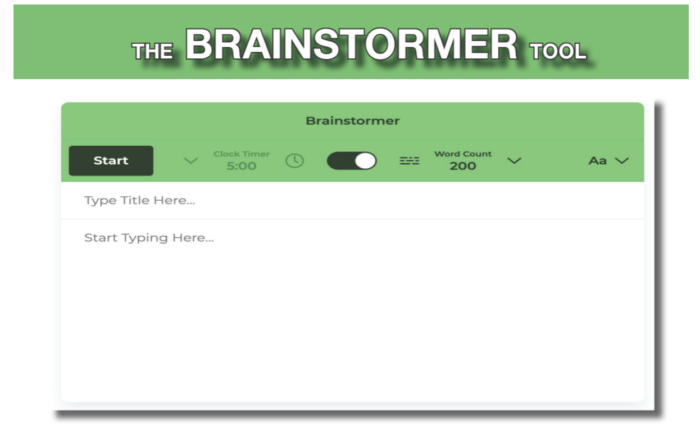Harness the POWER of the BRAINSTORMER Book Writing Tool
The Brainstormer combines sprint writing and freewriting techniques, which have been proven to be highly effective in helping writers break through writer’s block, generate new ideas, and produce high-quality writing in a short time. The Brainstormer Book Writing Tool is a free online book writing software that the Insider Expert has specifically designed to help writers finish their manuscripts faster.
The Brainstormer Book Writing Tool will help you turn your average story into an extraordinary one by using techniques that explore topics and organise the thoughts and ideas circulating in your mind onto paper.

When you have your topic out of your head and onto paper, you can see it in detail, increasing the likelihood of finding something innovative and new. Wouldn’t you like to expand your subject or story by generating new strategies and approaches to your idea?
You will usually start with general ideas, but you need to identify specific issues (some of these include rare and unique selling points that others have missed). Then, when you complete your creative writing session on the Brainstormer Book Writing Tool, you should come away with the bones of your synopsis.
You can brainstorm before starting your book or while working on it; however, you must create a time and space to use the Brainstormer Book Writing Tool.
If you have been struggling for hours to write only a few hundred words, or you are choking out your creativity with your inner editor then try using the Brainstormer Book Writing Tool as your sprint writing tool to accomplish more with focussed writing so you can finish your book faster.
You can use the Brainstormer Book Writing Tool for:
- Your Sprint Writing session
- Your Freewriting brainstorming session
- Your Looping brainstorming session
The Brainstormer is a powerful writing tool that can help you unlock your writing potential, get past mental barriers, and let your words flow. In this post, I talk about the following topics and how the The Brainstormer Writing Tool uses them:
- What is Sprint Writing?
- What is the Freewriting Technique?
- What is the Looping Technique?
- Best Practices for using the Brainstormer Book Writing Tool
- Parting Advice
“Get it down. Take chances. It may be bad, but it’s the only way you can do anything really good.”
William Faulkner
What is Sprint Writing?

Have you ever sat staring at your screen, waiting for your creative muse to inspire the right words for your manuscript? Then, as those long, drawn-out minutes turn into hours resulting in only a page of words written, you become discouraged and disheartened. Some people call it writers’ block, and some call it perfectionism. There is also the scenario a writer may face when they have too many commitments or obligations to meet and don’t have much time to spend on their manuscript.
Well, writing sprints may be the answer. Sprint writing is short bursts of writing during a specified time that help you write more words faster. It is where you set a timer and write as much as you can without editing and then stopping when the timer goes off. In addition, it increases your creativity because all your attention is on that specified intended task you want to accomplish with your writing.
Some writers have said that by using the sprint writing technique, they have finished their book three times faster.
“I write at high speed because boredom is bad for my health.”
Noel Coward

What is the Freewriting Technique?

Freewriting has also been called automatic writing and is a form of journaling. It’s a powerful way to get in touch with your unconscious creativeness and a powerful weapon against writer’s block. Freewriting is a remarkable tool where ideas and words flow out uncensored in a short period.
The key is to write everything that comes to your head; even if you don’t know what to write, write until you reach your goal. Again, it’s letting your thoughts go where they want on a subject.
Freewriting helps liberate your writer’s voice.
There are two schools of thought when freewriting, you can write using a timer or write using a word count. The one rule you need to remember is don’t stop until you reach your goal either by a timer or word count.
“You can’t think yourself out of a writing block; you have to write yourself out of a thinking block.”
John Rogers
What is the Looping Technique?

The looping method is a continuation of freewriting; author Peter Elbow developed this technique.
Like the freewriting technique, you have a timer that you set for 5 to 10 minutes and you write without stopping until the buzzer goes off. The difference is that you do it again and again. One after another until you have a freewriting sequence, each becoming more specific than the last.
Write. Just do it. Then again. Then some more. And more. Do not wait for inspiration; if you do enough of it often enough, inspiration will eventually come.
Nancy Kress

Best Practices for using the Brainstormer Book Writing Tool

- If you can go for a walk, it will stimulate your creativity.
- Take a shower to get your dopamines and mind ready.
- Find a quiet place and clear your mind.
- If you only schedule a small window of time to write because of your obligations, then close your eyes and take a few deep breaths before you begin.
- Open the Brainstormer Book Writing Tool.
- You can select whether you want to use a clock timer or a word count timer. However, if you are doing a sprint writing session, you would need to use the clock timer.
- The clock timer on the Brainstormer Book Writing Tool is in 5, 10, 15, 20 and 30-minute sessions. Some find that the 15-minute session for Sprint Writing works best for them but it is all matter of personal choice how long you want to write for.
- The word count timer on the Brainstormer Book Writing Tool is for 200, 300, 400 and 500 words.
“If I waited for perfection, I would never write a word.“
Margaret Atwood
- Be very clear on the intention or topic you want to write about, then type it into the title.
- Start typing whatever comes to your mind, don’t think about it, just type. That means turning off your inner editor while doing the task.
- Once the timer has finished, the program will ensure you can no longer type, and a download button will appear.
- The great benefit of using the Brainstormer Book Writing Tool is that you can download your writing session onto your own computer as a docx or txt document.
- Having your completed Brainstorming session on your own computer or as a printout means you can review and highlight whatever is useful or whatever you thought was meaningful that stirs your interest.
- You file all your completed Brainstorming sessions into a computer folder or print it out and file it into a physical folder.
- You can reset the online Brainstormer Book Writing Tool to start a new session again and again.
- You can also find a writing buddy to compete with to see who has the most word count after your Brainstorming session.
“Start writing. No matter what. The water does not flow until the faucet is turned on. ”
Louis L’Amour
Parting Advice

At the end of the day, you are the writer and the choice is yours. If you have hit the wall and are struggling to finish your creative writing project and nothing is working. Don’t you think it is time to connect your unique ideas and thoughts to your fingertips and have a massive breakthrough in your creative writing? Why not give the Brainstormer Book Writing Tool a shot, you have got nothing to lose except writer’s block. Share it with your writing buddy and see who can write the most words.

“If writing a book is impossible, write a chapter. If writing a chapter is impossible, write a page. If writing a page is impossible, write a paragraph. If writing a paragraph is impossible, write a sentence. If writing a sentence is impossible, write a word and teach yourself everything there is to know about that word and then write another, connected word and see where the connection leads.”
Richard Rhodes

Set yourself up for Success
Learn how to do research for a book and lay the foundations for a compelling and realistic story.
